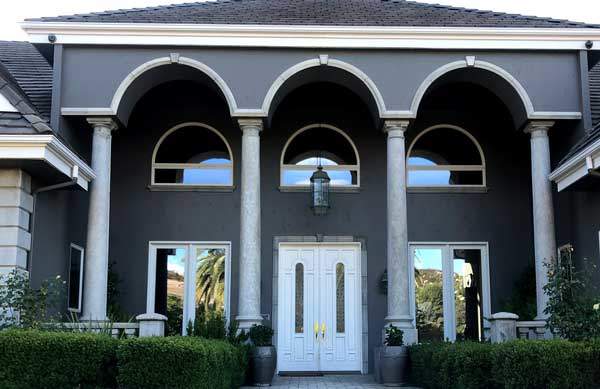Upgrade Your Home with Expert Residential Window Tint Providers
Upgrade Your Home with Expert Residential Window Tint Providers
Blog Article
How Residential Home Window Tinting Enhances Your Home's Energy Performance
Residential home window tinting presents a compelling solution for homeowners looking for to boost power efficiency within their living rooms. By using specialized movies to windows, it properly decreases warm transfer, consequently supporting indoor temperature levels and decreasing the need for too much heating or air conditioning.
Recognizing Window Tinting
Understanding window tinting is necessary for homeowners seeking to enhance both convenience and power performance in their home. Residential Window Tint. Home window tinting involves the application of a slim film to the interior or outside surface area of glass home windows. This film can significantly regulate the amount of sunlight and warmth that enters a home, hence affecting interior climate conditions
There are numerous kinds of window tinting films available, each with unique residential or commercial properties. The efficiency of home window tinting is often measured by its Visible Light Transmission (VLT) portion, which indicates just how much light can pass with the movie.
Advantages of Power Efficiency
Home window tinting not only enhances looks but likewise plays a substantial function in boosting power effectiveness within domestic rooms. By minimizing heat transfer via home windows, colored movies produce a much more steady interior climate, which can result in significant reductions in power consumption for cooling and heating. This energy effectiveness translates into lower utility expenses, giving home owners with considerable long-lasting cost savings.

Additionally, window tinting improves the comfort of living areas. By lessening glow and blocking harmful UV rays, colored windows produce an even more pleasurable atmosphere, which can lead to enhanced well-being for residents. The protection versus UV rays additionally helps preserve furniture and floor covering from fading, adding to the durability of house products.
How Tinting Functions
Tinting films operate via a combination of advanced products and innovations created to manage the amount of solar power getting in a home. Mainly made up of polyester, these films frequently integrate ceramic or metal bits that mirror and soak up warm. This twin ability enables them to significantly decrease the penetration of ultraviolet (UV) rays and infrared radiation while allowing visible light to pass through.
The effectiveness of home window tinting is determined by its solar warm gain coefficient (SHGC), which suggests just how much solar power is transmitted through the home window. Reduced SHGC worths are better as they represent higher heat denial. In addition, home window colors can include a range of shades, permitting property owners to personalize their visual choices while boosting energy performance.
Moreover, these movies work as a barrier, stopping warmth loss during colder months by reflecting interior warmth back into the home. This thermal insulation result matches the air conditioning benefits obtained throughout warmer months, adding to a balanced interior environment year-round. By managing solar energy efficiently, residential window tinting not only improves convenience however also plays a vital role in lowering energy intake and decreasing energy expenses.
Choosing the Right Color

There are numerous types of home window films offered, including dyed, metalized, and ceramic. Ceramic movies supply outstanding warmth control without endangering exposure and are highly durable, making them a prominent selection.
Noticeable light transmission (VLT) is another crucial element, as it indicates the amount of natural light that can travel through the tinted glass. Home owners ought to pick a color with a VLT that matches their lights choices while still supplying adequate glow reduction.
In addition, examining the solar warmth gain coefficient (SHGC) can aid establish how well a tint can obstruct warmth from sunlight. A reduced SHGC suggests better warm control, eventually boosting energy performance.
Setup and Upkeep Tips
Correct installment and maintenance are check these guys out important components in maximizing the advantages of property window tinting. To attain optimal outcomes, it is advisable to work with a qualified expert for setup. This ensures that the color is used correctly, staying clear of air bubbles, wrinkles, or misalignment that can jeopardize efficiency. Professionals likewise make use of specialized strategies and devices, which can enhance the sturdiness and effectiveness of the tint.
Complying with installation, upkeep is vital to lengthen the life of the home window movie. It is advised to wait a minimum of thirty day before cleaning up the tinted home windows to allow the glue to treat completely. When cleaning, make use of a soft cloth and a mild, ammonia-free cleaner to prevent harming the movie. Prevent unpleasant products that might scrape the surface area.
Attending to these concerns immediately can avoid additional damage and preserve power performance. By sticking to these setup and maintenance pointers, house owners can ensure their home window tinting continues to supply significant power financial savings and comfort for years to come.
Verdict
In conclusion, domestic window tinting offers as a reliable option for improving power effectiveness within homes. By lowering warm transfer and obstructing damaging UV rays, home window films add to reduce power intake and boosted indoor convenience.
Window tinting includes the application of a slim movie to the inside or exterior surface of glass home windows. By lowering warmth transfer with windows, tinted films create Web Site a much more stable indoor environment, which can lead to significant reductions in power usage for heating and cooling.The performance of home window tinting is measured by its solar heat gain coefficient (SHGC), which shows how much solar power is sent with the window. By managing solar power successfully, domestic window tinting not only boosts comfort yet additionally plays an important role in lowering energy consumption and reducing energy expenses.
By lowering heat transfer and obstructing dangerous browse around here UV rays, window movies add to reduce energy consumption and enhanced interior convenience.
Report this page